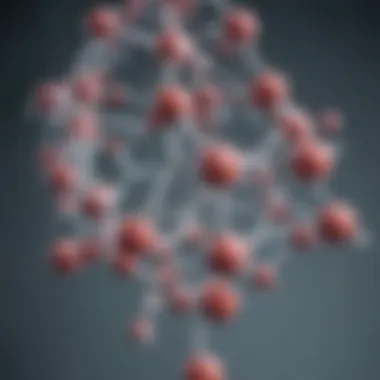Understanding the Role of GnRH Injections in Male Hormonal Health


Intro
The regulation of male hormones is a complex affair, intricately tied to various physiological mechanisms that govern many facets of health and well-being. At the heart of these regulations is Gonadotropin-Releasing Hormone (GnRH). The importance of GnRH injections can easily be overlooked by those not in the know. However, they interface significantly with hormonal balance, fertility treatments, and a plethora of clinical scenarios.
Research Overview
The exploration of GnRH injections opens the doors to understanding how this hormone orchestrates the delicate symphony of male reproductive health. Let’s break down the essentials here.
Summary of Key Findings
Research indicates that GnRH acts on the pituitary gland, triggering the release of luteinizing hormone (LH) and follicle-stimulating hormone (FSH). This in turn stimulates the testes to produce testosterone, which is critical for the male reproductive system. Studies reveal that the administration of GnRH can significantly influence testosterone levels and fertility outcomes in men, potentially offering new avenues for treatment options.
Research Objectives and Hypotheses
The focal point of this research lies in understanding the efficacy of GnRH injections in regulating male hormonal functions. The underlying hypothesis suggests that targeted GnRH therapy can correct hormone imbalances and enhance fertility in specific populations such as men with hypogonadism. This research aims to unravel the potential benefits while also addressing any associated risks, aiming for a balanced perspective on GnRH interventions.
Methodology
To unpack the role of GnRH in male hormonal regulation, a thorough examination of various studies is essential. Each brings its own flavor of findings and methodologies, shaping a deeper understanding of the subject matter.
Study Design and Approach
Our approach involves reviewing randomized controlled trials (RCTs) and observational studies that highlight the biochemical pathways influenced by GnRH. This provides a solid foundation for a detailed analysis of its therapeutic applications.
Data Collection Techniques
The data collection relies heavily on both qualitative and quantitative methods, pulling from medical records, patient interviews, and hormone level tests to paint a fuller picture. This blend of data sources helps ensure that the analysis is not just comprehensive but also practical for real-world applications.
"Regulating male hormones isn't just about fertility; it’s a cornerstone of overall male health."
Time and again, the evidence has spoken about the centrality of GnRH in the hormonal dialogue. It’s essential to appreciate the multiple layers that play into both its therapeutic promise and its potential pitfalls.
Preamble to GnRH and Its Importance
Gonadotropin-Releasing Hormone (GnRH) plays a crucial role in male hormonal regulation. Understanding it is essential for comprehending how hormonal balance is maintained in men and how various therapies can address hormonal imbalances. GnRH's significance extends beyond just being a hormone; it's a key player in the physiological processes that govern male health. Awareness of this hormone and its functions can have several benefits, including enhancing the understanding of fertility issues, managing hormone-related diseases, and contributing to broader discussions about male health.
Understanding Gonadotropin-Releasing Hormone
GnRH is a decapeptide hormone produced in the hypothalamus, and its primary function is to stimulate the pituitary gland to release luteinizing hormone (LH) and follicle-stimulating hormone (FSH). These hormones are pivotal in regulating the gonadal function, influencing sperm production, and sustaining testosterone levels. Without GnRH, the cascade of hormonal events necessary for male reproductive health would not occur.
In essence, GnRH acts as the conductor of an intricate hormonal orchestra, ensuring all parts perform in harmony.
Historical Perspective of GnRH Research
The discovery of GnRH can be traced back to the 1970s, when a group of researchers led by Andrew V. Schally embarked on groundbreaking studies that revealed the role this hormone plays in the endocrine system. This was a significant milestone that redirected the path of many biological and medical sciences. GnRH’s identification shifted the goalposts in understanding endocrine disorders. Researchers soon realized that manipulating GnRH could potentially lead to new treatments for a range of conditions, including infertility and certain cancers. The evolution of GnRH research shows a fuller picture of its effects and opens doors for innovative therapeutic approaches.
Physiological Role of GnRH in Males
GnRH is not just the beginning of the hormonal cascade; its influence stretches across various physiological parameters. It regulates the synthesis and release of sex hormones, mainly testosterone, which is vital for several bodily functions, including:
- Sperm production and maturation
- Libido (sexual drive)
- Bone and muscle health
- Health of the cardiovascular system
Given the extent of these roles, any disruption in GnRH levels can lead to significant health issues such as hypogonadism, infertility, and even osteoporosis. This underscores the importance of GnRH in maintaining not just reproductive health but overall well-being in males.


"Understanding GnRH is akin to holding a key that unlocks many facets of male health. Its influence reaches far and wide, affecting everything from reproduction to overall vitality."
This overview of GnRH sets the stage for deeper discussions about its mechanisms, therapeutic uses, risks, and research. The breadth of GnRH's impact on male hormonal regulation demonstrates its integral role in men's health and the need for ongoing research in this area.
Mechanism of Action of GnRH
Understanding the mechanism of action of Gonadotropin-Releasing Hormone (GnRH) is pivotal in grasping how it influences male hormonal regulation. GnRH acts as a maestro, orchestrating the delicate interplay between hormones. By initiating and regulating the secretion of key hormones from the pituitary gland, its role is irreplaceable. Through the precise action on various receptors, GnRH contributes to crucial processes such as the production of testosterone and sperm maturation.
The Hypothalamic-Pituitary-Gonadal Axis
The Hypothalamic-Pituitary-Gonadal (HPG) axis is a vital part of how male hormonal regulation works. The hypothalamus, a tiny region in the brain, serves as the command center. When the hypothalamus releases GnRH, it travels to the pituitary gland, triggering the release of two gonadotropins: Luteinizing Hormone (LH) and Follicle-Stimulating Hormone (FSH). A balance here is crucial.
- LH: This hormone stimulates Leydig cells in the testes to produce testosterone, vital for male traits and reproductive functions.
- FSH: On the other hand, FSH promotes spermatogenesis by acting on Sertoli cells, ensuring an adequate supply of sperm.
When functioning correctly, this axis ensures continual semen quality and hormone levels. However, factors such as stress, obesity, and aging can disrupt this balance.
Understanding the nuances of the HPG axis helps explain how GnRH injections can restore hormonal function, particularly in men dealing with issues like hypogonadism or fertility problems.
GnRH Receptors and Signaling Pathways
A pivotal player in the action of GnRH are its receptors, primarily located in the pituitary gland. These receptors are responsible for binding GnRH and starting a chain reaction of signaling events that culminate in hormone secretion. This step is not merely a one-off event; it's a finely tuned process.
- GnRH receptor subtypes are primarily GnRHR (GnRH receptor), which activates multiple intracellular signaling pathways once it binds to GnRH.
- The resulting activation leads to the second messenger systems like cAMPand inositol triphosphate, ultimately spurring gonadotropin release.
In this regard, any alterations or disruptions in the signaling pathways can lead to significant changes in hormone levels. For example, a malfunctioning GnRH receptor can result in reduced LH and FSH levels, leading to decreased testosterone production and fertility challenges.
This intricate ballet of timing and binding underlines why precise administration of GnRH injections is significant. By understanding how GnRH influences these pathways, researchers can develop targeted therapies for various male health issues.
Indications for GnRH Injections in Males
Gonadotropin-Releasing Hormone (GnRH) has emerged as a crucial player in male hormonal regulation. Its injections have various applications in therapeutic settings, addressing several health issues. Understanding these indications is paramount for both medical professionals and affected individuals, as they illuminate how GnRH can restore balance in the male endocrine system. The three primary indications for GnRH injections in males are treatment of hypogonadism, fertility restoration strategies, and management of certain cancers.
Treatment of Hypogonadism
Hypogonadism, a condition where the body doesn't produce sufficient testosterone, can lead to myriad health concerns including fatigue, decreased libido, and diminished muscle mass. Administering GnRH injections is often used as a management strategy for males diagnosed with this condition. GnRH works by stimulating the pituitary gland to release luteinizing hormone (LH) and follicle-stimulating hormone (FSH), which in turn stimulates the testes to produce more testosterone.
This approach can be particularly beneficial for men who have secondary hypogonadism, where the issue stems from the pituitary gland rather than the testes themselves. Regular injections can help revitalize the hormonal axis, allowing many of its physiological functions to resume. However, the treatment carries some risks and must be carefully monitored. Every patient is unique, and medical professionals have to tailor the dosage and frequency of injections based on individual response and hormone levels.
Fertility Restoration Strategies
For men facing challenges with fertility, GnRH injections can serve as a vital tool in treatment plans. Typically, male infertility may be linked to hormonal imbalances that prevent spermatogenesis. By using GnRH, healthcare providers can correct these imbalances, boosting sperm production. The process tends to be gradual and requires regular assessments.
In this context, understanding the underlying causes of infertility is crucial. Conditions like hypothalamic dysfunction or pituitary disorders can hinder testosterone and sperm production. For these cases, GnRH injections can be particularly effective, delivering a series of strategic pulses to enhance the male reproductive hormone levels. And while it doesn't guarantee conception, many couples have found success after incorporating GnRH treatment into their fertility journey.
Management of Certain Cancers
Another significant indication for GnRH injections is in the management of hormone-responsive cancers, particularly prostate cancer. In cases where the cancer relies on testosterone for growth, GnRH analogs function to suppress the production of this hormone. Essentially, these injections signal the body to lower testosterone levels, thereby reducing the fuel available for cancerous cells to thrive.
It's worth noting that the use of GnRH injections in cancer management is not without its challenges. The side effects can be quite impactful, and management plans must take into account the patient's overall health and specific cancer biology. Nonetheless, this approach has shown promise and can form part of a comprehensive treatment strategy that also includes therapies such as radiation or surgery.
"The administration of GnRH not only plays a crucial role in restoring hormonal balance but also paves the way towards optimizing fertility and managing cancer effectively. It's a testament to the complex interplay between hormones and health."
In summary, GnRH injections offer multifaceted solutions for various male health issues, from hormonal imbalances to fertility issues and cancer treatment. A deeper appreciation of these indications will not only aid those receiving treatment but also inform ongoing research and clinical practices in the field.


Benefits of GnRH Administration
The role of Gonadotropin-Releasing Hormone (GnRH) injections in male hormonal regulation cannot be overstated. By addressing hormonal imbalances, improving fertility prospects, and managing certain cancers, the application of GnRH injections presents a multifaceted approach to male health. This section will delve into three significant benefits: the restoration of hormonal balance, the potential improvement in fertility outcomes, and the management of hormone-dependent tumors.
Restoration of Hormonal Balance
Achieving hormonal equilibrium is crucial for overall male health. GnRH injections work by stimulating the pituitary gland to release luteinizing hormone (LH) and follicle-stimulating hormone (FSH), which in turn prompt the testes to produce testosterone. The restoration of testosterone levels can alleviate symptoms associated with testosterone deficiency, such as fatigue, low libido, and mood disturbances.
Moreover, this balancing act doesn’t just concern testosterone. A restored hormonal balance can influence other aspects like bone density, muscle mass, and even psychological well-being. With regular GnRH administration, patients can experience a significant enhancement in their quality of life beyond just the physical symptoms.
Potential Improvement in Fertility Outcomes
For men struggling with infertility, GnRH injections can offer a beacon of hope. By stimulating the natural production of hormones necessary for sperm production, GnRH can positively affect sperm count and motility. Clinical studies have shown that men receiving GnRH injections might exhibit increased spermatogenesis, leading to successful pregnancies in their partners.
- Stimulation of LH and FSH levels encourages the testes to produce sperm.
- When combined with other fertility treatments, such as in vitro fertilization, GnRH may yield even better outcomes.
- Many fertility specialists consider GnRH therapy as a foundational step before moving on to more invasive procedures.
These findings underscore the importance of early diagnosis and intervention in male infertility, utilizing GnRH as a part of a broader fertility restoration strategy.
Role in Managing Hormone-Dependent Tumors
GnRH injections have also carved out a niche in the realm of oncology. Certain hormone-dependent tumors, particularly prostate cancer, depend on testosterone for growth. By manipulating the body's hormonal environment, GnRH can effectively reduce testosterone levels. This action can slow the progression of malignancies and even induce remission in some cases.
Understanding the clinical significance of GnRH injections in cancer treatment involves recognizing the following:
- Reduced testosterone levels can decrease the growth of hormone-sensitive tumors.
- New treatment protocols often incorporate GnRH in conjunction with other anti-androgen therapies for maximal efficacy.
- Ongoing research continues to uncover new applications, positioning GnRH as a versatile player in the oncological toolbox.
"The appropriate use of GnRH therapy not only alleviates the symptoms of hormonal imbalance but also enhances fertility and aids in the management of certain cancers, making it a vital tool in modern medicine."
In summary, the benefits of GnRH administration extend far beyond mere hormonal management. From restoring equilibrium and enhancing fertility to effectively combating hormone-sensitive cancers, GnRH's multifaceted role reinforces its significance in contemporary clinical practice.
Risks and Considerations
The use of Gonadotropin-Releasing Hormone (GnRH) injections is often accompanied by a variety of risks and considerations that merit careful assessment. While GnRH may offer considerable benefits in terms of hormonal regulation and treatment strategies for male patients, it is crucial to weigh these advantages against potential adverse effects and long-term implications. This section delves into the common side effects associated with GnRH injections, examines the long-term implications of ongoing treatment, and outlines patient selection criteria. By illuminating these considerations, practitioners and patients alike can make informed decisions about GnRH therapy.
Common Side Effects of GnRH Injections
Though GnRH injections can be life-changing, they are not without their downsides. Patients might experience a range of side effects, many of which are transient but should not be overlooked. Commonly reported side effects include:
- Local reactions at the injection site: Pain, swelling, or redness may occur, usually resolving within a few days.
- Flushing or hot flashes: Hormonal fluctuations can lead to feelings of warmth or sudden flushing, which some might find uncomfortable.
- Mood swings: The impact of GnRH on hormone levels can affect mood stability, leading to emotional variability in some patients.
- Changes in libido: Both increases and decreases in sexual desire have been reported, depending on individual responses to therapy.
- Headaches and fatigue: Some individuals may experience persistent headaches or unusual fatigue after beginning treatment.
Patients should be counseled about these potential side effects prior to beginning therapy, allowing them to address concerns proactively. By having a thorough discussion about what’s in store, both healthcare providers and patients can foster a more collaborative approach.
Long-term Implications of Treatment
Understanding the long-term implications of GnRH injections extends beyond the immediate physical side effects. Over time, the influence of GnRH on the hormonal landscape could lead to a range of effects on overall health. Some key points to consider include:
- Impact on bone density: Long-term use of GnRH can lead to reductions in testosterone levels, potentially increasing the risk of osteoporosis and bone fractures.
- Metabolic health considerations: Changes in hormone levels might influence metabolic rates, affecting weight management and insulin sensitivity.
- Psychological well-being: Prolonged hormonal therapy can have psychological ramifications, including mood disorders or a sense of emotional instability.
- Fertility concerns: If GnRH therapy is not carefully managed, it might result in diminished fertility in some patients, especially if starting from a baseline of reduced testosterone levels.
Staying attuned to these factors is essential in patient management to ensure outcomes align with personal health goals.
Patient Selection Criteria
Not every individual is an ideal candidate for GnRH therapy. Therefore, careful patient selection involves a detailed assessment of various factors. Key criteria include:


- Age and overall health: Younger patients may respond differently than older individuals. Patients’ overall health status plays a big role as well.
- Specific diagnosis: Conditions such as hypogonadism or hormone-sensitive cancers may warrant GnRH therapy, but other unrelated health issues might contraindicate it.
- Personal history of hormonal therapies: Previous use of hormone-modulating treatments could affect how a patient responds to GnRH injections.
- Psychosocial factors: Consideration should be given to the patient’s psychological resilience and support systems, as mental health can impact treatment adherence and outcomes.
By establishing sound criteria for patients considered for GnRH injections, clinicians can optimize the therapeutic effects while minimizing risk.
Current Research and Future Directions
Research surrounding Gonadotropin-Releasing Hormone (GnRH) injections in male hormonal regulation has increasingly gained traction. With the continuous evolution of medical science, the exploration of novel applications and methodologies is spearheading advancements in this field. Moreover, understanding the intricate nature of hormonal balance holds significant promise for improving male health outcomes. This section sheds light on the latest findings and potential developments that may influence the future landscape of GnRH therapy.
Emerging Studies on GnRH Variants
A notable area of interest lies in the study of GnRH variants. These modified forms of the natural hormone may possess unique properties that enhance efficacy or reduce side effects. By using peptides that have been engineered to interact differently with GnRH receptors, researchers could tailor treatments to specific conditions, offering possibilities that were previously unachievable.
For instance, some studies have demonstrated that analogs like acetylated GnRH have a prolonged half-life compared to traditional forms. Such findings could potentially optimize dosage frequency and improve patient compliance.
"Innovations in GnRH variants could redefine how we approach therapy for hormonal disorders, making treatments not just effective but also patient-friendly."
Innovations in Delivery Methods
In tandem with the research on GnRH variants, innovations in delivery methods stand as a critical focus. Traditional injection protocols, while effective, often present challenges related to adherence. Recent advancements have explored alternative delivery systems, from subcutaneous implants to intra-nasal formulations.
- Implants: These provide steady dose release over an extended period, minimizing the burden of regular injections.
- Nasal sprays: Quick-acting and user-friendly, they stand to improve the uptake of GnRH in patients who may be reluctant to use needles.
Such methods not only foster better adherence but can also potentially enhance the therapeutic outcomes. They open doors for broader applications in clinics and can improve accessibility for patients who might have difficulties with traditional administration.
Community and Global Perspectives
Finally, understanding the community and global perspectives on GnRH injections is paramount. There is a growing recognition of the importance of patient-centered approaches in healthcare. This includes actively involving patients in their treatment decisions, providing education about the role of GnRH in managing their condition, and addressing cultural variations concerning hormonal treatment.
Moreover, global disparities in access to hormone therapies must be addressed. As research progresses, efforts to collaborate internationally could enhance understanding of different patient populations and lead to more equitable health solutions.
- Partnerships: Collaborative studies between countries can bring fresh insights and shared knowledge, encouraging innovative strategies.
- Awareness Campaigns: Raising awareness about GnRH therapy can demystify its use and promote acceptance in varied communities.
As the scientific community continues to build upon the foundational knowledge of GnRH, these avenues of research not only deepen our understanding but could also lead to transformative changes in male health management.
Finale
The conclusion serves a critical function in solidifying the readers’ understanding of the intricate relationship between GnRH injections and male hormonal regulation. Throughout this article, we've navigated the depth of knowledge surrounding Gonadotropin-Releasing Hormone, shedding light on its multifaceted roles. The summary encapsulated here will not only reinforce the key points discussed but also set the stage for implications and future exploration.
Summary of Key Points
- Physiological Significance: GnRH plays a pivotal role in regulating the hypothalamic-pituitary-gonadal (HPG) axis, initiating key processes in testosterone production and fertility.
- Indications for Use: The therapeutic applications, including hypogonadism treatment, fertility restoration, and management of hormone-sensitive cancers were discussed, illustrating its clinical relevance.
- Benefits vs. Risks: While there are clear advantages, such as hormonal balance restoration and improved fertility outcomes, potential risks like injection-related side effects also warrant careful consideration.
- Emerging Research: Ongoing studies on GnRH variants and innovations in delivery methods suggest an evolving landscape for treatment, prompting continued discourse on best practices in hormonal health.
- Global Context: The article emphasizes the need to remain informed about varying perspectives on GnRH’s role in treatment strategies across different communities and healthcare systems.
Final Thoughts on GnRH in Male Health
The discourse surrounding GnRH is far from a simple recitation of facts; rather, it embodies a broader conversation about hormonal regulation and its intricacies. Given the implications for male health ranging from fertility to cancer management, GnRH deserves thoughtful attention from both medical professionals and patients. Advocates for its use must tread carefully, balancing the undeniable benefits with associated risks and individual patient needs. As research continues to unfold, the understanding of GnRH could very well redefine aspects of male healthcare in the years to come.
Ultimately, GnRH injections represent a significant tool in the arsenal of treatment options available today, with their success rooted in informed decision-making and tailored application to suit each patient’s unique situation.
Cited Works
The cited works within this article serve several purposes:
- Validation of Claims: Every assertion made regarding the physiological effects of GnRH injections is underpinned by established research. This lends authority to the information presented.
- Resource for Further Investigation: Interested readers can dive deeper thanks to meticulously listed studies. For instance, studies published in peer-reviewed journals provide an excellent basis for understanding how GnRH influences hormonal balance.
- Connection Between Theory and Practice: Many articles and papers link experimental findings with their therapeutic implications, bridging the gap between lab research and real-world application. Readers can explore the original works that have shaped today's understanding of GnRH injections in the clinical landscape.
Further Reading
For those wishing to expand their knowledge on GnRH and its applications, several resources are highly enlightening:
- Emerging Research: New studies continually reshape our understanding of GnRH. Journals like Endocrinology and Journal of Clinical Endocrinology and Metabolism present cutting-edge findings.
- Broader Context: Understanding the hormone cycle requires looking beyond GnRH. Resources that delve into the HPG (Hypothalamic-Pituitary-Gonadal) axis can provide a comprehensive outlook on how hormones interact.
- Practical Guidelines: For professionals involved in administering treatments, literature detailing practical guidelines on GnRH administration can enhance patient outcomes. Resources such as UpToDate offer real-world patient care insights.
As we engage with these sources, the relevance of accuracy in scientific documentation becomes ever clearer. A well-cited article not only equips the reader with the necessary knowledge but also fosters a holistic understanding of the complex interplay of hormones, particularly in male health.















